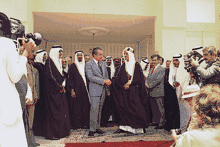Bisht (clothing)
A bisht (Arabic: بِشْت) or mishla (Arabic: مِشْلَح) or ʿabāʾ (Arabic: عَبَاء) is a traditional men’s cloak popular in the Arab world.[1] It is a flowing outer cloak worn over a thawb.

A symbol of Arab identity
A bisht is usually worn for prestige on special occasions such as weddings, or festivals such as Eid, or for Ṣalāt al-Jumuʿah or Salat al-Janazah. It is usually worn by secular officials or clergy,[2] including tribal chiefs, kings, and imams, over a kanzu or tunic. It is a status garment, associated with royalty, religious position, wealth, and ceremonial occasions, like the black-tie tuxedo[3] in the West.[2][4][5]
Colour
It is usually black, brown, beige, cream or grey in colour.[2]
Etymology
The triliteral root of Bisht is widely used in Semetic Languages, including Arabic, and a theory is that the word bisht is derived from Akkadian ‘bishtu’, meaning ‘nobility’ or ‘dignity’.[6] The alternate name of ʿabāʾ (Arabic: عَبَاء) is from the Arabic triliteral root ʿAyn-Bāʾ-Wāw, which relates to 'filling out'.
References
-
- "Traditional & modern: The Saudi man's bisht". 7 November 2012.
- Urbanarabian. "B – Sweater – Over Sized Sweater". Urbanarabian. Archived from the original on 2016-09-11. Retrieved 2016-05-23.
- Hannah (27 April 2011). "Saudi Arabian Bisht".
- "صانع بشوت الحكام وكبار الشخصيات "البراهيم" لـ"الأحساء نيوز":صنعت بشت الملك فهد وابنه – صحيفة الأحساء نيوز". www.hasanews.com.
- "الثقافة الشعبية". www.folkculturebh.org.
- "البشت في الخليج العربي". www.abuhaleeqa.net.
- ناصر حسين العبّودي (1987). الأزياء الشعبية الرجالية في دولة الإمارات وسلطنة عمان. مركز التراث الشعبي لدول الخليج العربية،. pp. 121, 127, 129.
- ناصر حسين العبّودي (1987). الازياء الشعبية الرجالية في دولة الامارات وسلطنة عمان. pp. 121, 127, 129.
- http://dar.bibalex.org/webpages/mainpage.jsf?PID=DAF-Job:57506
- "كتاب الازياء الشعبية الرجالية في دولة الإمارات وسلطنة عمان". التبراة : عالم الكتب.
- http://www.raya.com/File/Get/2e58845b-9cc2-428c-abd1-c56523208548
- Najlā Ismāʻīl al-ʻIzzī al-Wahhābī (2003). أزياء قطرية. جمعية الفن الإسلامي،. p. 12. ISBN 978-0-9544445-2-5.
- S. D. Goitein (1983). A Mediterranean Society: Daily life. University of California Press. pp. 464–. ISBN 978-0-520-04869-0.
- Abū al-Maḥāsin Yūsuf Ibn Taghrībirdī (1960). History of Egypt, 1382-1469 A.D.: 1382-1399 A.D. University of California Press. p. 108.
- Al-Mukhtar, Rima (7 November 2012). "Traditional & modern: The Saudi man's bisht". Arab News.
- "Kate dusts off her Alexander McQueen tuxedo for stunning appearance". Evening Standard. 2020-10-13. Retrieved 2020-10-15.
- "Traditional & modern: The Saudi man's bisht". Arab News. 2012-11-07. Retrieved 2020-10-15.
- "A symbol of Arab identity". Gulf News. Retrieved 2020-10-15.
- Dr. Ali Fahmi khashim, Akkadian Arabic Dictionary Page 140